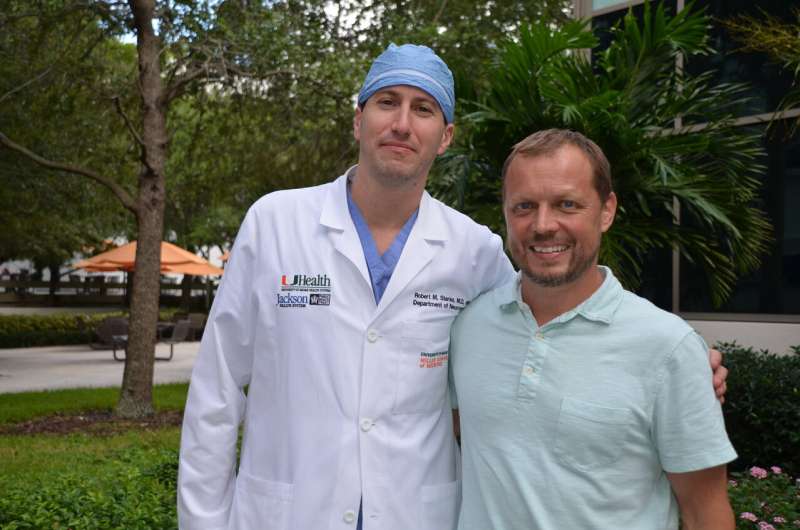Dr. Robert Starke and his patient Brian Bedard, who received the stent. Credit: Roberto Suazo/University of Miami Miller School of Medicine
Robert M. Starke, M.D., M.Sc., an experienced neurosurgeon and researcher with the University of Miami Health System and Miller School of Medicine, has been conducting laboratory studies on a specialized stent designed to treat complex aneurysms in the blood vessels of the brain.
"Our preliminary research here indicates that stents can redirect the flow of blood, while potentially reducing the risk of stroke," he said. "It has a special coating to prevent the formation of blood clots that can travel to the brain while the aneurysm is being treated."
The Miller School is one of a few academic centers in the U.S. selected for an upcoming clinical trial of the flow-diverting stent that has surface modifications. The goal of these modifications is to decrease the chance of clot formation and improve the chances of aneurysm obliteration, said Dr. Starke, who is professor of neurological surgery and radiology, co-director of endovascular neurosurgery at UM/Jackson Memorial Hospital, and director of neurovascular research. The stent is already in use in Europe, Dr. Starke said.
"We have a high volume of cerebral aneurysm cases, including patients from all of Florida, other states and countries," he said. "This gives us a unique perspective because we often see some of the most difficult and dangerous cases."
Treating a Dangerous Complex Aneurysm
With his familiarity with the specialized stent, Dr. Starke was able to obtain emergency FDA approval of the device to treat a Vero Beach patient with a life-threatening ruptured aneurysm. Brian Bedard, a 45-year-old contractor, was working on a construction project last spring when he felt a sudden pain in the back of his head. After several hours, his wife took him to the emergency room, where a brain scan detected the aneurysm.
He was transferred to a second hospital, and then because of the severity and complexity of his dangerous condition, Bedard was transported by air ambulance to UM/Jackson Memorial Medical Center.
"I hadn't been doing anything strenuous at work, when the aneurysm ruptured," said Bedard. "I felt nauseous and my memory was starting to go. My doctors in Vero Beach told me I had a brain bleed, but I didn't realize how dangerous it was until I was rushed into the operating room in Miami."
Dr. Starke said Bedard's aneurysm was in a major artery deep in the brain. "Because there were several blood vessels coming out of the sides of the ruptured artery, we had to find a way to treat the aneurysm without blocking the other blood vessels," he said. "This type of aneurysm is rare and is associated with bad outcomes."
Fortunately, Dr. Starke was already studying the new stent. He quickly applied to the U.S. Food and Drug Administration for a "compassionate use" exemption that would allow him to implant the device in Bedard's artery. After the stent arrived from California, Dr. Starke placed it in the aneurysm using an interventional approach
Without Dr. Starke and the UM/Jackson team, Bedard says his outcome could have been very different. "We are lucky to have such a great team of neurosurgical experts right here in South Florida," he said. "They took great care of me, monitoring my condition because of the risk of a stroke. I feel very fortunate to make a full recovery.
"Now I am back at work, and that wouldn't have happened without their great knowledge, skills and experience."
Addressing Challenging Aneurysms
Dr. Starke considers Bedard lucky, as his ruptured aneurysm occurred in the wall of a major artery that serves many smaller blood vessels deep in the brain. While it only occurs once in about 1,000 aneurysms, it is normally associated with fatal outcomes. "It's very rare that patients survive those types of aneurysms," said Dr. Starke. "Even if the aneurysm is repaired, many patients have multiple strokes afterwards."
In the upcoming clinical trial, participants will receive the stent and will be followed to observe how they react to the device and how it affects their aneurysm. "Our background research looked at surface modifications for stents that would lead to better aneurysm obliteration with fewer complications," said Dr. Starke. "Our goal in the trial is to continue evaluating whether the stent is a better treatment option for aneurysms."
For Dr. Starke, seeing patients like Bedard make a full recovery after treatment is very gratifying. "Seeing something that takes many years of research come to fruition and help patients like Brian is really amazing."



















